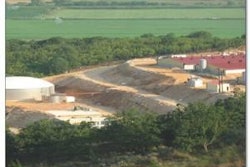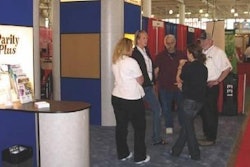It’s easy to leave easy money on the table by not having feed trucks and trailers set right and managed properly, experts say, but changes that collectively add up to big savings are relatively easy to make.
For starters, “gearing the truck properly is critical to optimizing fuel economy,” says Scott Barraclough, powertrain sales manager for Mack Trucks, Allentown, Pa. “Know how fast your trucks will be driven. Gear the vehicle for 1,400 to 1,500 RPM at the desired cruise speed.” It’s very important, he adds, for feed managers to “spec the vehicle” properly with their truck dealer, “all the way from the engine to the road,” such things as the transmission and power train. In general, he says, trucks that are ‘spec-ed’ properly save 5% to 7% in fuel costs over those that are not. He notes that new engines will generally operate at lower RPMs than those built just a few years ago. Furthermore, he says, ordering a truck “just like the last one” will probably not be optimized for economy.
Keep road speed down
Another major way to save on fuel, Barraclough says, is to simply “keep the road speed down. Be reasonable with the top speed.” The rule of thumb is that at highway speeds, a 1 MPH decrease in speeds will improve fuel economy 0.1 MPG. For example, if a truck is driven at 70 miles per hour instead of 65 that comes to $3,500 to $4,000 lost if the truck is driven 100,000 miles per year assuming diesel prices of $2.85 per gallon.
Looking at this another way, a truck with excellent aerodynamics saves 5% to 8% in fuel costs by being driven 5 mph slower, while a truck with poor aerodynamics saves even more, 10% to 15%. Because of this, Barraclough recommends setting the vehicle to a reasonable speed, such as 68 MPH. He also says to use the lower gear vehicle limiting speed (LGVLS) to encourage use of top gear. If LGLVLS is enabled, this setting specifies the highest vehicle speed allowed in any gear below the transmission’s top gear.
Barraclough also says that while the best drivers may do better with their foot, “most drivers will get better fuel economy using cruise control.” In general, cruise control improves fuel economy by 6%.
Barraclough also says that excessive engine idling can burn fuel unnecessarily. He recommends that an “idle shutdown time” be set at 5 minutes.
In addition, “aerodynamics plays a huge role in fuel economy.” For example, full roof fairing versus nothing can improve MPG by up to 15%.
On fuel, Barraclough says that while blended fuels provide better startability and protection against fuel gelling than standard No. 2 diesel, fuel efficiency decreases. Summer fuel improves mileage up to 3% more than winter fuel. Some biodiesel blends can also affect mph, he says. B20 fuel has been shown to reduce MPG by 1%, while a B5 blend shows a negligible difference in fuel economy.
All these are important, Barraclough states, but the biggest variable of all is the driver. “Driver behaviour can account for up to 30% variation in fuel economy,” he says, noting such variables as driving in the proper gears and the proper RPMs. Because of this, driver training is important, he says.
Lightweight aluminium trucks/trailers
There are other ways to save fuel that go far beyond the truck. One is to use lightweight aluminium trucks/trailers designed and loaded for the best use of axle capacity, says Doug Tecken, product manager for Sudenga, George, Iowa. Tecken says operators should haul “the maximum possible weight” each time the feed transport leaves the mill.” Frequently, he says, feed transports leave with unused capacity or are too full, which can result in fines.
Another, he says, is to oversize feed transport compartments so they easily filled and time isn’t wasted levelling loads.
It’s important to have a feed transport equipped to allow efficient positioning of the auger, Tecken says, which saves time and unnecessary idling. Radio control is a good example here, he says, and also a front unload trailer. Both can save a considerable amount of time getting “set-up.” It also is important to size the PTO properly, he says. “If it is not, the engine will run at a higher RPM than it should.”
Regular lubrication of bearings and pivots of the unloading system and vehicle suspension and keeping optimal tire pressure will result in savings of fuel, repair parts, and time.
One key way to reduce fuel costs is to reduce the amount of time unloading “by going with high capacity unloading systems,” says Butch Medemblik, manager, engineering and plant operations, Walinga Inc., Guelph, Ontario, Canada. He adds that a significant amount of farm unloading “is high horsepower demand,” which uses fuel and that can be reduced by increasing unloading capacity. Another important way to cut fuel costs, he says, “is to incorporate aerodynamics into the unit.” Yet another way to reduce fuel costs, he says, is to use lighter trailers, which increases product per load, thus decreasing the total number of loads required.
Maintaining consistent operating speeds also reduces fuel needs, Medemblik says, as does having routine maintenance programs keeps equipment maintained properly.

















